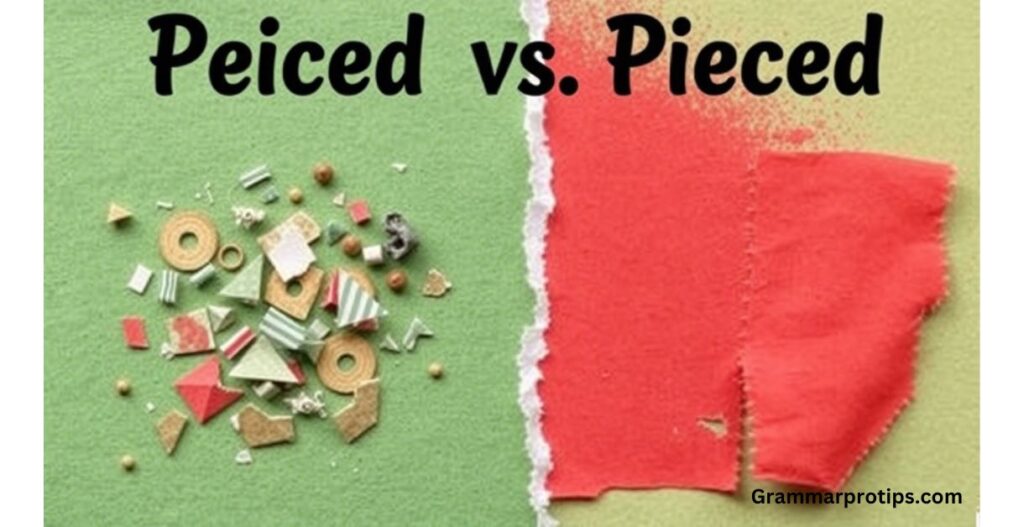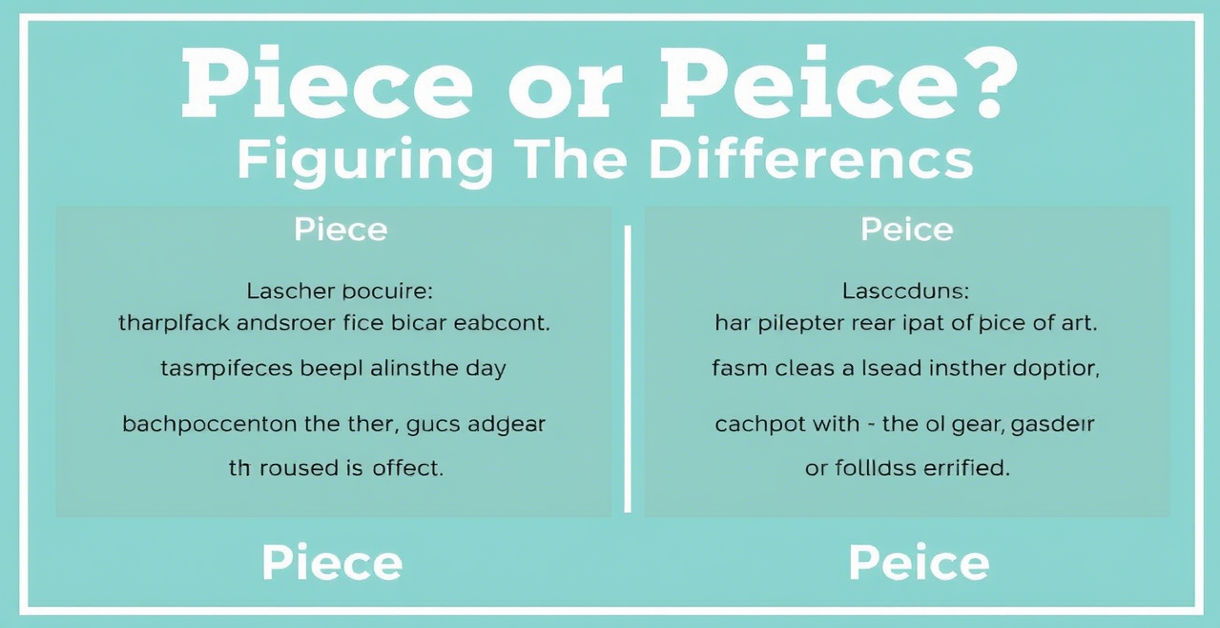When it comes to mastering the English language, even the smallest details can make a big difference. One such detail is the distinction between “piece” and “peice.” While they may look similar at first glance, only one of them is correct. Let’s dive into this topic with clarity and examples to help you avoid common mistakes in your writing.
What Does “Peice” Mean? Spoiler Alert: Nothing!
If you’ve ever typed “peice” instead of “piece,” don’t worry—you’re not alone. Many people mistakenly use “peice” as a misspelling of the correct word. But here’s the truth: “peice” has no meaning in English. It’s simply a typing error that often slips past spell-checkers.
For example, imagine sending an email like this:
Subject: Follow-Up on Project
Hi Rachel,
I wanted to share my thoughts on the report. Unfortunately, I think we’re missing a crucial peice of information. Could you clarify what data was used for the analysis?
Best regards,
Jason
In this scenario, Jason likely meant to say “piece” but accidentally wrote “peice.” This small mistake might seem harmless, but it can affect how professional your writing appears. To ensure clarity in writing, always double-check for typos like this.
The Correct Spelling: “Piece”

Now let’s focus on the star of the show: “piece.” This versatile word has multiple meanings depending on the context. Here are some common uses:
- Part of something: A portion or fragment.
- Slice: A section cut from a larger whole.
- Work of art: A creative creation, such as a painting or sculpture.
- Puzzle piece: One component of a larger puzzle.
- Chess piece: A game token in chess.
- Advice piece: A written or spoken suggestion.
Let’s explore these meanings further with real-life scenarios.
Scenario 1 – Email About a Missing Puzzle Piece
Imagine you’re working on a team-building exercise involving puzzles. You send an email to your colleague:
Subject: Puzzle Completion Status
Hey Mark,
We’re almost done assembling the puzzle, but we realized one piece is missing. Do you happen to have it? Without that final fragment, we can’t complete the picture.
Thanks,
Linda
Here, the word “piece” refers to a single unit of the puzzle. Using the correct spelling ensures there’s no confusion about what you’re referring to.
Scenario 2 – Writing an Article About Art
Suppose you’re drafting an article about a famous painting. You might write:
The artist’s latest work of art is a stunning depiction of nature. Each brushstroke adds depth to the overall composition, making it a masterpiece worthy of admiration. This piece showcases her unique style and talent.
In this case, “piece” describes a creative work. Using precise language enhances the quality of your writing.
Common Mistakes: Peiced vs. Pieced

Another frequent error involves conjugating the verb form of “piece.” Some writers mistakenly write “peiced” instead of the correct “pieced.” For instance:
Incorrect:
She carefully peiced together the broken vase.
Correct:
She carefully pieced together the broken vase.
This subtle difference highlights the importance of proofreading your work. Remember, correct usage matters in both casual and professional writing.
Peice or Piece Meaning: Why Context Matters
Understanding the peice or piece meaning requires looking at the context. Below is a table summarizing their differences:
| Word | Meaning | Example Usage |
|---|---|---|
| Piece | A part, portion, or segment | “Can I have a piece of cake?” |
| Peice | Misspelling; no meaning | N/A |
As shown above, “piece” is the only valid option. Always choose it over “peice” to maintain accuracy in your communication.
How Do You Spell Piece of Cake?
One fun phrase where “piece” shines is “piece of cake.” This idiom means something is very easy to do. For example:
Completing the assignment felt like a piece of cake because I had all the resources I needed.
Using idioms like this makes your writing more engaging and relatable. Just be sure to spell “piece” correctly!
Piece or Peace: Another Source of Confusion
Sometimes, writers mix up “piece” with “peace.” While they sound alike, their meanings differ entirely:
- Piece: Refers to a part, portion, or object.
- Peace: Denotes tranquility or harmony.
For example:
Incorrect:
After years of conflict, the two nations finally signed a treaty for a lasting piece.
Correct:
After years of conflict, the two nations finally signed a treaty for a lasting peace.
To avoid language errors, always consider the intended meaning before choosing a word.
Peice (Misspelling) and Its Impact on Writing

The misspelling of “peice” is a classic example of a typing error that can undermine your credibility. Even if the rest of your content is flawless, a single mistake can distract readers. Consider this excerpt from a blog post:
In today’s fast-paced world, finding time for self-care can feel impossible. However, dedicating just 10 minutes a day to mindfulness can provide a much-needed peice of calm.
Doesn’t that sound off? Replacing “peice” with “piece” instantly improves the sentence:
…can provide a much-needed piece of calm.
Small changes like this go a long way in ensuring your message resonates clearly.
PIECES: When Quantity Comes Into Play
When discussing multiple items, the plural form PIECES comes into play. For instance:
The chef prepared three exquisite pieces of sushi for the tasting menu.
Or:
After hours of searching, they found all the missing pieces of the antique vase.
Using the plural form correctly emphasizes quantity without losing specificity.
H2: Writing Tips to Avoid Errors Like “Peice”
To minimize writing errors, follow these practical tips:
- Proofread Thoroughly: Always review your text for typos and inconsistencies.
- Use Tools Wisely: Leverage tools like Grammarly or Hemingway Editor to catch mistakes.
- Read Aloud: Hearing your words can reveal awkward phrasing or errors.
- Practice Regularly: The more you write, the better you’ll become at spotting issues.
By adopting these habits, you’ll elevate the quality of your work and reduce the likelihood of embarrassing blunders.
Peice or Piece Movie: A Hypothetical Example
Let’s imagine a movie titled “Peice or Piece.” The plot revolves around a detective solving a mystery involving stolen artifacts. At one point, the protagonist says:
“We need to find the missing piece of the ancient map. Without it, we’ll never uncover the treasure.”
Notice how using “piece” maintains coherence within the dialogue. A title like “Peice or Piece” would confuse audiences, underscoring the importance of proper spelling.
Conclusion: Embrace Clarity and Precision
Mastering the difference between “piece” and “peice” is a simple yet impactful step toward improving your writing. By understanding the nuances of each term and applying them appropriately, you’ll communicate more effectively and professionally.
Whether you’re crafting emails, articles, or creative stories, remember these key takeaways:
- Use “piece” for parts, portions, or objects.
- Avoid the misspelling of “peice.”
- Prioritize clarity in writing to engage your audience.
With practice and attention to detail, you’ll eliminate common mistakes and produce polished, compelling content every time.
Final Thought
Language is a powerful tool, and mastering its intricacies allows you to connect with others more deeply. So next time you’re unsure whether to write “piece” or “peice,” pause and reflect. Your choice could mean the difference between confusion and crystal-clear communication.

“Smith is the dedicated admin of [grammarprotips.com], a platform focused on enhancing grammar skills. With a passion for language and education, Smith strives to make grammar accessible and enjoyable for learners of all levels. Committed to delivering high-quality content, Smith continually explores innovative ways to help users master the complexities of grammar.”

